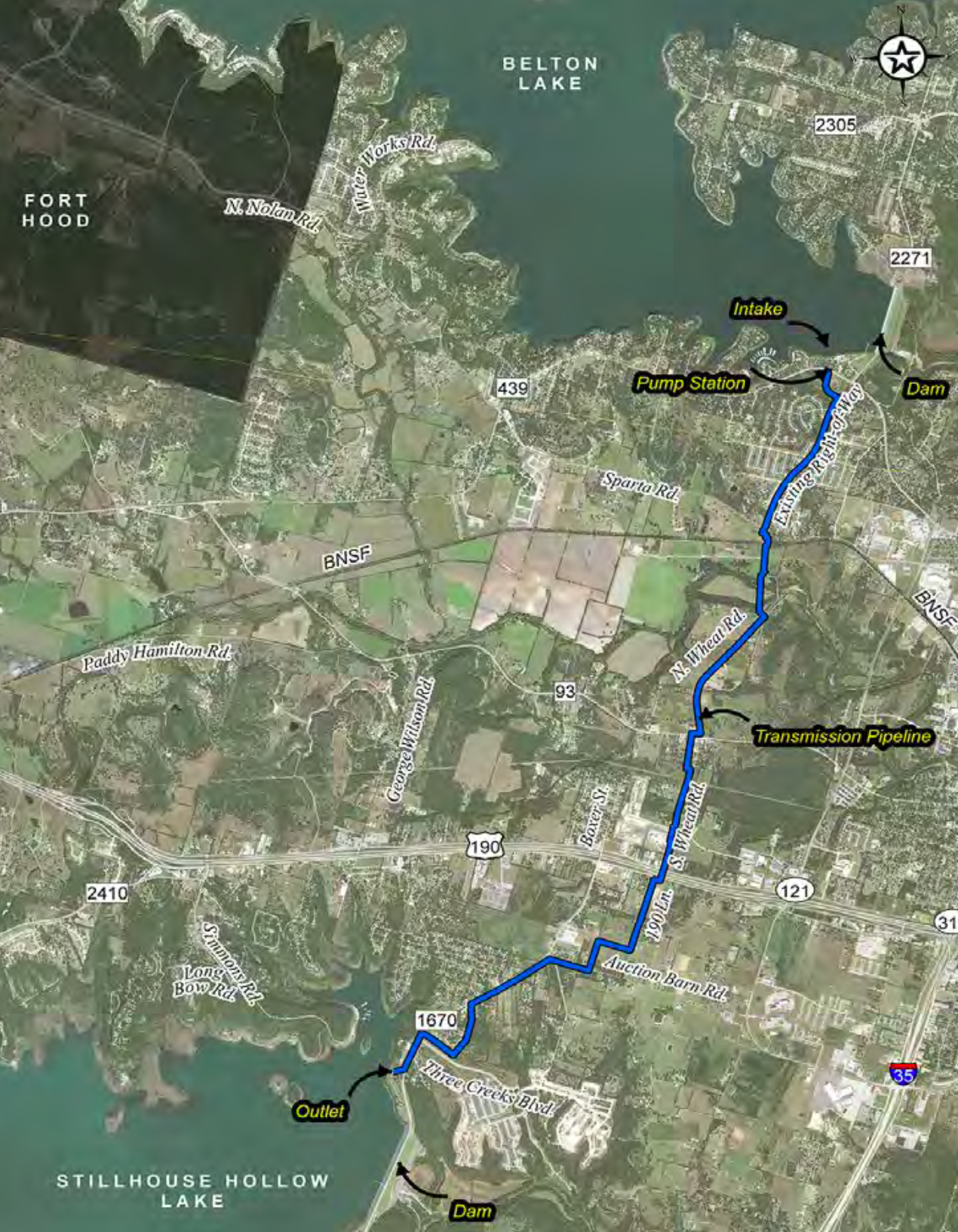Construction of 7-mile Belhouse pipeline linking Belton Lake to Stillhouse likely to begin in 2028
October 14, 2025
By David Stone
The Belton Journal
Construction on a one-way pipeline connect- ing Belton Lake to Still- house Hollow Reservoir is expected to begin in 2028 and be operational by 2032, according to an ex- pert with the Brazos River Authority.
BRA is a governmen- tal entity responsible for developing, managing and protecting the water resources of the Brazos River Basin in Texas. Its activities include operating reservoirs and dams, man- aging water supplies for municipalities, agriculture, and industry, and provid- ing wastewater services.Construction on a one-way pipeline connect- ing Belton Lake to Still- house Hollow Reservoir is expected to begin in 2028 and be operational by 2032, according to an ex- pert with the Brazos River Authority.
“The permitting and design phase for the proj- ect began in May of this year,” said Brad Brunett, chief operations officer for the Authority. “Design for both the intake structure and pipeline are underway by the Walker Partners en- gineering team and they are expected to be com- plete in early 2026.”

Courtesy graphic
Map shows route, intake pump house and output station of the Belhouse pipe- line, which will move water from Belton Lake to Stillhouse Hollow. Water then could be piped from Stillhouse to Lake Georgetown to provide water to homes in Austin’s northern suburbs.
“Coordination with the US Army Corps of En- gineers is also in progress — construction is expected to begin in 2028,” Brunett said.
He said the pipeline route that was presented at the public hearing in 2023 will be pursued, with some minor deviations as a re- sult of recent development.“Coordination with the US Army Corps of En- gineers is also in progress — construction is expected to begin in 2028,” Brunett
The pipeline will al- low water to flow from Belton Lake to Stillhouse, to provide water for drought-related needs in Austin’s booming northern suburbs.
“As populations in the Georgetown and Round Rock areas grow, there won’t be enough water for Brazos River Authority customers served by Lake Georgetown,” Brunett said.
“Lake Georgetown is small — Stillhouse is about 6 times larger than Georgetown, and Belton Lake is about 14 times larger,” he said. “During dry times, there simply is not enough water in Lake Georgetown to meet the needs.”
According to the U.S. Census Bureau, George- town is one of the fastest growing cities in America, and its population of 104,000 is expected to double in less than seven years.
The Brazos River Authority has been pump- ing water from Stillhouse to Lake Georgetown for years, but the potential amount of water being moved will soon increase, Brunett said.
A whopping 20 billion gallons of water every year could be piped from Still- house Hollow Reservoir to Lake Georgetown in the next few years, and up to 9.8 billion gallons could be moved annually from Bel- ton Lake to Stillhouse by the Belhouse pipeline.
We first started pumping in 2006, and we added multiple pumps in 2011,” Brunett said. “We have four pumps capable of pumping 42 million gallons a day. We are replacing those with four higher- capacity pumps that can move 56 million gallons per day. There will still be one pipeline, but we will be able to move more water.
“We are currently in the pump design phase, and it will be two or three years before they are op- erational,” he said. Once complete, they will have the capacity to transfer about 61,000-acre-feet — 19.88 billion gallons — from Stillhouse to George town annually.
The amount of water actually transferred is re- lated directly to ongoing drought conditions.
“The pumps don’t run constantly,” Brunett said. “It all depends on the weather and how much natural runoff goes into Lake Georgetown. In 2016, the pumps didn’t run at all. But, in 2022, they ran most of the year.”
The projected Bel- house pipeline connecting Belton Lake to Stillhouse will be approximately seven miles long and up to four feet in diameter.
According to Brunett, the intake structure will be located near Dead Fish Grill and the Belton Dam. The pipeline will feed into Stillhouse between the dam and Three Creeks Boulevard.
Brunett said the water lines from Belton Lake to Stillhouse and from Still- house to Lake Georgetown will be one-way. In other words, water cannot be pumped in reverse to trans- fer water into Belton Lake.
While the Brazos River Authority has deemed the pipeline solution that moves water from Belton Lake to Stillhouse, then to Lake Georgetown, as the best option for getting water to where it is needed, BRA has considered other options.
“We are always look ing for new water supply sources,” he said. “We have considered new res- ervoirs in the Little River watershed and in Milam County, but those were met with a lot of opposition from local residents so those options are no longer in our water plan.”
“All of the major riv- ers in Williamson and Bell Counties already have res- ervoirs, and there likely isn’t enough water to justify building new reservoirs on those rivers,” Brunett said. “The San Gabriel River has Lake George-town and Lake Granger, the Leon River has Bel- ton Lake and Lake Proc- tor, and the Lampasas has Stillhouse.”
“Another option we have looked at is raising the Lake Georgetown dam so the lake could hold more water. But, new development has gone in and that option is no longer on the table.”
According to Brunett, Belton Lake serves many water districts and municipalities. One of the largest customers is Belton-based 439 Water Supply, which provides water to Killeen, Harker Heights, Copperas Cove and parts of Fort Hood. The lake also pro- vides water to Bluebonnet Water Supply, Belton, Coryell Water Supply, Fort Gates, Gatesville, The Grove Water Supply and others.
Although Temple pulls its water from the Leon River below the Belton Dam, water must be released from the lake to meet the City’s water needs, Burnet said.
Bell County Judge David Blackburn said BRA contracts in place give water customers in the Georgetown area rights to water from Stillhouse.
“It is my understand- ing that current contracts afford the customers to our south the rights to the water,” Blackburn said. “It is also my understand- ing that no current system water rights holder will be impacted by a pipeline connecting Belton Lake and Stillhouse.”
The Belhouse Drought Preparedness Project — the official name of the water trans- port system linking Belton Lake to Stillhouse Hollow — has been planned for years to provide access to water where it is needed. It is designed to delay the need for the development of additional new sources of water, including the building of new reservoirs, which could cost millions, if not billions of dollars.
“With growth and development occurring in Bell County, I think it would be wise for Bell County water purveyors to explore strategies that will better ensure that our water needs in the future are met,” Blackburn added.
“Aquifer Storage & Recovery is but one ex- ample of a strategy that should continue to be ex- plored in order to better ensure that the water needs of Bell County are met in the years to come,” Black-burn said.
Aquifer Storage & Recovery is the process of injecting water into the ground for storage and later recovering that water for use. One common use of ASR is for management of peak demand and raw water supply in public drinking water systems.
Temple is already launching an Aquifer Storage & Recovery system and other Bell County en- tities are considering following suit.









